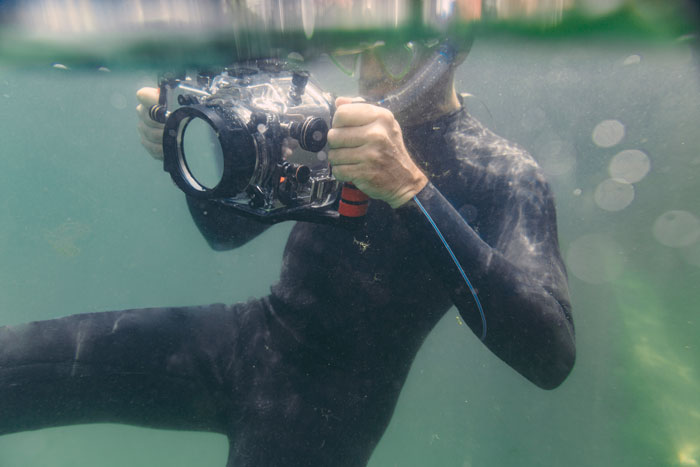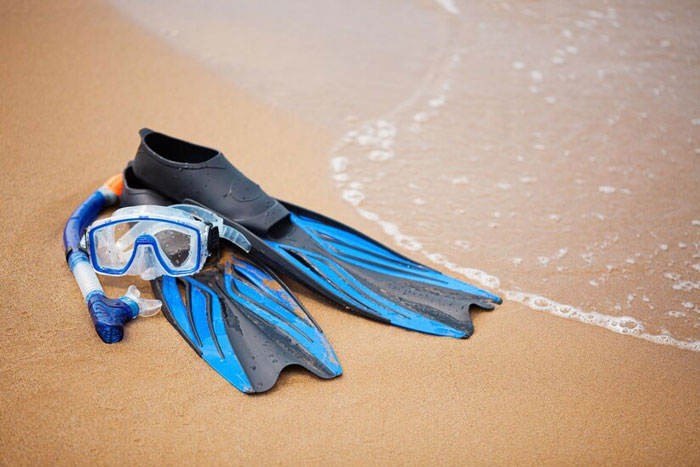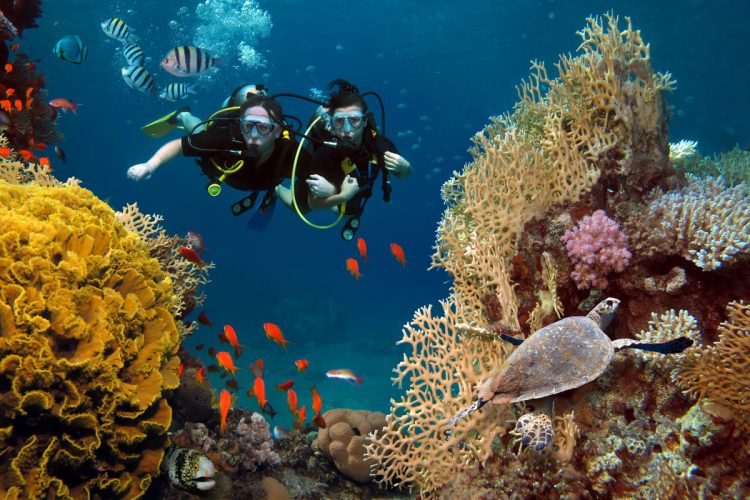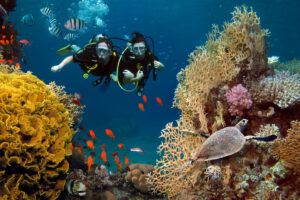Discover the Red Sea Marine Life in Egypt
Diving in the Red Sea offers an extraordinary experience, where the captivating aspect lies in its diverse marine life. From the smallest nudibranch to the largest whale shark, this underwater paradise is a mesmerizing kaleidoscope of marine organisms, each more fascinating than the last. With over 1,200 species of fish, including some that are exclusive to this region, the Red Sea boasts a spectacular collection of biodiversity. As you explore the warm, clear waters, you may encounter rays, sharks, and dolphins, providing unforgettable sights for divers. Moreover, this marine ecosystem serves as a habitat for endangered species such as the green sea turtle and the hawksbill turtle, offering the potential for extraordinary encounters during each dive.
The Resilience of Red Sea Coral Reefs
The Red Sea coral reefs stand out as some of the most diverse and vibrant ecosystems on our planet, serving as a flourishing oasis for a multitude of marine creatures, from vibrant reef fish to graceful rays and elusive sharks. Diving in this remarkable environment truly offers a magical experience, thanks to the reefs’ health and vibrancy.
What sets the Red Sea Coral Reefs apart is their remarkable resilience. While many coral reefs worldwide have suffered from bleaching and degradation, these ecosystems have displayed an astonishing ability to withstand such challenges. This resilience can be attributed, in part, to the Red Sea’s unique characteristics, including its isolation and the interplay of environmental factors such as high salinity levels and warm water temperatures. The Red Sea Coral Reefs serve as a testament to nature’s ability to adapt and thrive even in the face of adversity, providing divers with an awe-inspiring and unforgettable journey.
Ancient Wrecks and Scuba Diving in Egypt
Scuba diving in Egypt offers more than just spectacular natural sights. The Red Sea’s floor is a graveyard for countless shipwrecks, remnants of the vast maritime history of the area. Divers can explore these sunken vessels, like the SS Thistlegorm, a British ship sunk during World War II, now considered one of the best wreck diving sites globally.
The Joy of Red Sea Underwater Photography
For those passionate about capturing the underwater world’s beauty. The Red Sea’s unique conditions make it a paradise for Red Sea underwater photography. Crystal clear visibility, vibrant and diverse marine life, and colourful coral gardens set the stage for incredible underwater photos. From macro subjects like nudibranchs and tiny shrimp to wide-angle shots of coral walls and shipwrecks, the opportunities for underwater photographers are endless.
Egypt Snorkeling: A Glimpse of the Underwater World
If diving isn’t for you, Egypt snorkeling in the Red Sea offers a fantastic alternative. The shallow coral reefs provide a home for countless species of colorful fish, easily visible from the surface. With just a mask, snorkel, and fins, you can float above these vibrant ecosystems, witnessing the beauty of the Red Sea without ever having to descend below the surface.
Indeed, the Red Sea offers a world of exploration and discovery, whether you’re diving deep below the surface, photographing the vibrant marine life, or just snorkeling on a sunny day. Its rich biodiversity and the unique experiences it offers make it a must-visit destination for any ocean enthusiast. So what are you waiting for? Dive in and discover the wonders of Egypt’s underwater paradise!

Underwater photography equipment for capturing the beauty of the Red Sea
We can suggest some underwater photography equipment that could help you capture the beauty of the Red Sea. However, remember to consider your budget, expertise level, and specific needs when choosing your equipment.
- Underwater Camera: The choice of camera is critical. Popular options range from advanced point-and-shoot cameras like the Olympus Tough TG-6 to more professional DSLR and mirrorless cameras like the Canon EOS R5 or the Sony A7R IV.
- Underwater Housing: This is a must-have to protect your camera underwater. Brands like Ikelite, Nauticam, and Sea & Sea offer high-quality housings for various camera models. Make sure the housing is specifically designed for your camera model.
- Strobes: Good lighting is key in underwater photography. Strobes provide artificial light to help capture vibrant, well-lit photos. Popular models include the Sea & Sea YS-D2J and the Ikelite DS161.
- Wide-Angle Lens: A wide-angle lens is ideal for capturing large subjects like coral reefs or shipwrecks. If you’re using a DSLR or mirrorless camera, consider lenses like the Canon EF 16-35mm f/2.8L III USM or the Sony FE 16-35mm f/2.8 GM.
- Macro Lens: For capturing smaller creatures like nudibranchs or tiny fish, a macro lens is a great choice. The Canon EF 100mm f/2.8L Macro IS USM or the Sony FE 90mm f/2.8 Macro G OSS are excellent options.
- Underwater Tray and Arm System: This helps to mount your camera and strobes, providing stability and control when shooting underwater.
- Red Filter: This helps correct the blue or green color cast that can occur in your images when diving in deeper waters.
- Underwater Photography Guide or Course: If you’re new to underwater photography, consider investing in a guidebook or an online course that can provide valuable tips and techniques.
Always remember to rinse your equipment with fresh water after each dive to protect it from saltwater and sand damage. Enjoy your underwater photography adventure in the Red Sea!
The Precautions to take into account before diving underwater
Safety should be a top priority when planning for any scuba diving adventure. Here’s a list of precautions to keep in mind:
- Get Certified: Before you go diving, ensure you’ve received proper training and certification from a recognized diving organization like PADI or NAUI.
- Check Your Equipment: Always inspect your diving equipment before a dive. Check for any signs of wear and tear or malfunctioning parts.
- Plan Your Dive: Know the specifics of your dive site. Understand the current, visibility, depth, and potential hazards of the area.
- Never Dive Alone: Always dive with a buddy. In case of emergencies, having another person around can be lifesaving.
- Know Your Limits: Don’t push beyond your comfort zone or training level. If you’re not confident or experienced in deep dives or specific environments (like caves or wrecks), don’t risk it.
- Stay Healthy and Fit: Scuba diving can be physically demanding. Ensure that you are physically fit, well-rested, and properly hydrated before diving.
- Avoid Alcohol and Drugs: Never dive while under the influence of alcohol or drugs, as they can impair your judgment and increase your risk of decompression sickness.
- Monitor Your Air: Always keep an eye on your air supply and plan your dive to end with a sufficient reserve of air.
- Ascend Slowly and Safely: Ascend slowly from your dive (no faster than 18 meters/60 feet per minute) to avoid decompression sickness, and perform a safety stop at the end of each dive.
- Respect Marine Life: Remember not to touch, feed, or harass marine life. Maintain good buoyancy control to protect the coral reefs.
- Stay Informed: Keep updated with the latest safety protocols and refresh your skills regularly with courses or training sessions.
Remember, safety first! Always be prepared and cautious to ensure a safe and enjoyable diving experience.

Some common signs of wear and tear to look for in diving equipment
Regular inspection of your diving equipment is crucial to ensure safety during your dives. Here are some common signs of wear and tear to look out for in your diving gear:
- Scuba Tanks:
Check for rust or corrosion, especially around the valve area.
Look for dents or other damage to the tank body.
Ensure the valve opens and closes smoothly and does not leak.
- Regulators:
Listen for any leaks. You can usually hear a continuous hissing sound if there’s a leak.
Check the mouthpiece for any signs of damage or wear.
- BCDs (Buoyancy Control Devices):
Inspect for any leaks. You can do this by inflating the BCD and listening for escaping air.
Check all clips and buckles for functionality.
Look at the low-pressure inflator hose connection for any signs of wear or damage.
- Dive Computers and Gauges:
Ensure the display is easy to read and not scratched or cracked.
Check that the buttons function correctly.
Make sure the battery level is sufficient.
- Dive Masks:
Look for any cracks in the lens or frame.
Check the skirt (the part that seals against your face) for tears.
Make sure the strap is in good condition and adjusts properly.
- Fins:
Look for cracks or tears, especially around the foot pocket and strap areas.
Make sure the buckles and straps are functioning properly.
- Dive Suits:
Inspect for tears, especially in high-stress areas like under the arms or at the knees.
Check the seals around the wrists and ankles.
Examine the zippers for functionality and signs of corrosion.
- Weights and Weight Belts:
Check the weights for any signs of damage or corrosion.
Make sure the weight belt or weight system on your BCD releases easily.
If you find any signs of wear and tear, it may be time to service or replace that piece of equipment. Always remember that your safety is paramount, and reliable equipment is an essential part of safe diving.









